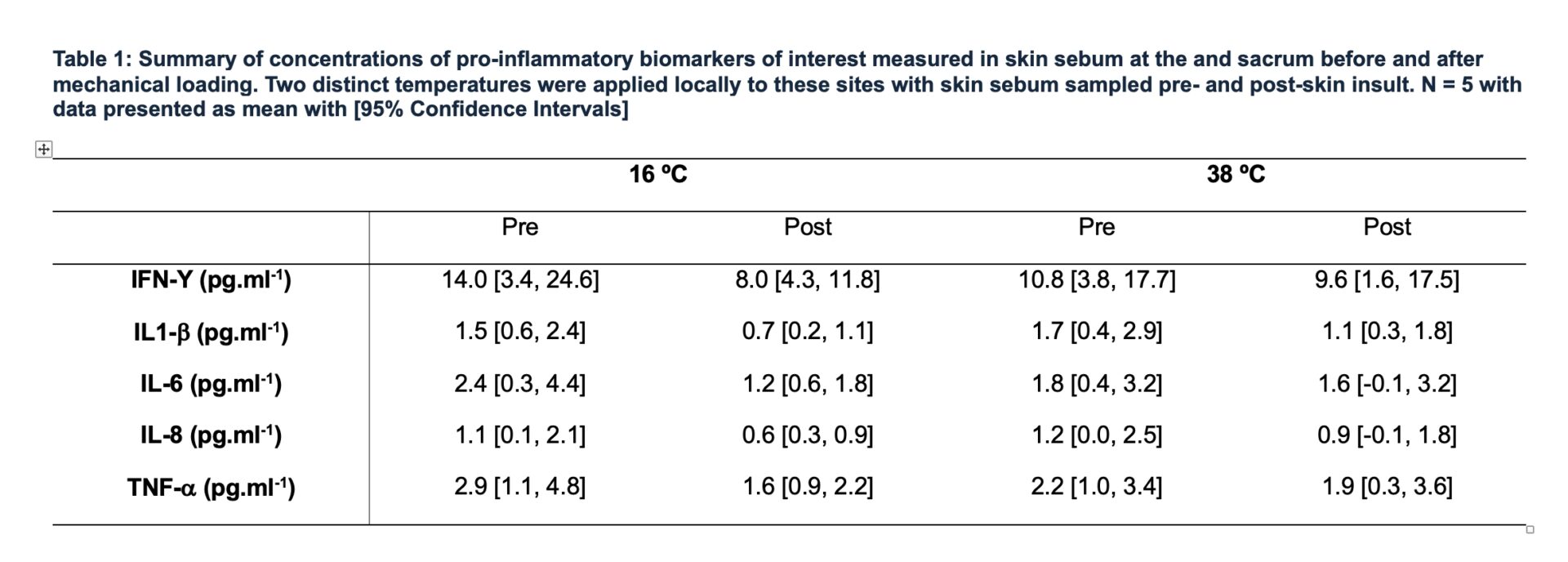Introduction
Pressure ulcers (PUs) are localised skin damage caused by prolonged pressure and shear forces (Kottner et al., 2019). PUs constitute a significant healthcare challenge, with chronic wound treatment costing approximately £8.3 billion annually in the UK. Elevated temperature and moisture levels within and around skin tissues can also increase the risk PUs; this has led to a growing interest in the therapeutic effect of localised skin cooling to maintain skin tissue viability.
Preliminary animal work indicates that local cooling and stimulation of cold-sensitive TRPM8-expressing neurones could modulate the skin’s inflammatory responses to acute mechanical stress (e.g. pressure loading) via downregulation of pro-inflammatory cytokines such as TNF-a (Lee et al., 2014). However, the extent to which skin cooling mitigates inflammatory responses to mechanical loading in humans remains unclear. The aim of this study was to investigate how localised cooling can modify in vivo inflammatory responses of the skin to mechanical loading and shearing in a cohort of healthy young adults.
Methods
Ethical approval was granted by the University of Southampton Ethics Committee (ERGO:88984). Twenty-two young adults (25±4y; 71±9Kg; 17±9cm) partook in 3 experimental sessions separated by a minimum of 24 hrs in a randomised cross-over design. During each session, participants underwent a standardised 75-min protocol to cause pressure-induced ischemia and post-occlusive hyperaemia at the sacrum, involving: i) a 10-minute baseline stabilisation with minimal pressure [17.5 mmHg (2.3 kPa)], ii) 45-minute loading phase [60 mmHg (7.9 kPa)], and iii) a 20-minute minimal pressure phase [17.5 mmHg (2.3 kPa)]). Participants’ skin over the sacrum was mechanically loaded and unloaded with a custom-built thermal probe, which, depending on the session, was set to either 38°C, 24°C, or 16°C. Skin sebum was collected non-invasively (Sebutape, CuDerm, Dallas, TX, USA) prior to and following each thermal conditions, and used to analyse up- or down-regulation of selected inflammatory biomarkers (TNF-a, IL1-β, IL-6, IL-8 and IFN-γ; Gordon et al., 2024) via extraction techniques optimised by our laboratory (MSD V-PLEX Pro-inflammatory panel 1 (Meso-Scale Discovery, Rockville, MD; Jayabal et al., 2023).
Results
At the time of writing, biomarkers analyses were completed in 5 participants. Preliminary observations indicated a small down-regulation of TNF-a following cooling (-1.3 pg.mL-1) but not warming at 38ºC (-0.3 pg.mL-1). A similar down-regulation was observed in IFN-g following 16ºC (-6.0 pg.mL-1) but not 38ºC (-1.2 pg.mL-1). Finally, IL- 6 also appeared to decrease after mechanical loading was applied at 16ºC (pre: 2.4 pg.mL-1, 95% CI[0.3, 4.4]; post: 1.2 pg.mL-1, 95% CI[0.6, 1.8]), but not at 38ºC (pre: 1.8 pg.mL-1, 95% CI[0.4, 3.2]; post: 1.6 pg.mL-1, 95% CI[-0.01, 3.2]).
Conclusion
These preliminary data indicated that localised skin cooling may blunt expression of some skin pro-inflammatory cytokines following sustained mechanical loading of the sacrum. Given that these cytokines are involved in the inflammatory cascade associated with the loss of skin integrity and development of PUs, localised skin cooling could offer promising therapeutic applications for the maintenance of skin tissue viability.

